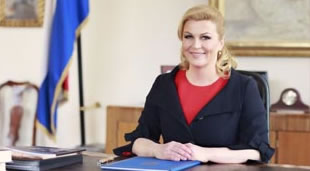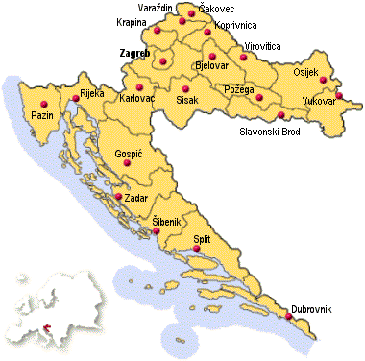
About Croatia
Economic sectors
Tourism:
Croatia offers various forms of tourism, with the Adriatic coast and islands, scuba diving, hunting and fishing, health tourism with 19 sea and mainland resorts, yachting with more than 40 marinas and 15,000 berths etc.
Industry:
In Croatia industry accounts for about one-fifth of the GNP and employs about one-quarter of the labour force. The largest sectors within industry in terms of production are: electrical engineering, food processing, chemicals, pharmaceuticals, textiles, wood processing, manufacture of machines and devices, shipbuilding and telecommunications equipment. Industrial exports make up about 97% of total Croatian commodity export.
Agriculture and food production: Agriculture plays an important role in Croatian economy. Together with forestry and fishing, agriculture accounts for about 8% of the GDP and employs approximately 6% of Croatian workforce. About 40% of the Croatian population live in the countryside, and about 70% of the agricultural land is owned by private farmers, with the balance owned by the state. Generally, Croatian agriculture could be self-sufficient.
Construction: Construction accounts for about 5% of the GNP in Croatia, and employs about 7% of the workforce.
Transport and Telecommunications: Transport and telecommunications sectors account for about 8% of the GDP and were also strongly affected by the war and the closing of borders.
The telecommunications network in Croatia is maintained by the Croatian Telecom, 51% owned by the Deutsche Telekom. There are also two mobile network operators: T-Mobile and VIPnet.
There are twelve free trade zones in Croatia. Besides the usual exemption from the tax and duty on all goods produced within the zone and destined for export, the users of the zone who invest in its infrastructure more than EUR 130,000 are exempt from the company tax for five years. Other users of the zone pay the corporate profit tax at 50% of the standard rate.
Gross Domestic Product: The GDP in the year 2000 was 19.03 billion USD, or 4255 USD per capita. Expressed in Croatian kunas or the currencies of the European Monetary Union, this is an increase by significant 3.8% (Because of the extremely high increase in the value of American dollar, the GDP and GDP per capita expressed in U.S. dollars showed decrease).
Inflation: In the last five years of the 1990s, Croatia was successful in maintaining the prices and exchange rate stability primarily owing to the tight and restrictive monetary policy. However, in the year 2000 the inflation was 6.2%.
Foreign debt: At the close of the year 2000, the foreign debt of Croatia amounted to about USD 10.8, or about 57% of the GDP realised during the same year. The debt in the ten months of the year 2001 amounted to USD 11.2 and it is estimated that its ratio to the GDP will remain the same.
The major trade partners per destination of the Croatian exports are Italy (USD 1104 million), Germany (689), Bosnia and Herzegovina (560), Slovenia (426) and Austria (268); and the major trade partners per source of the Croatian imports are Germany (USD 1547 million ), Italy, (1524), Slovenia (712), Russia (654) and Austria (631).
The establishment of a business incentive surrounding, in co-ordnance with the standards which prevail in the EU and countries with expanded market economies, is one of the primary aims of the economic policy of the Government of the Republic of Croatia.
Media: Public Television and Radio Station (HRT),
two private nation-wide television station,
10 regional stations.
Daily newspapers Vecernji List, Jutarnji List, Vjesnik, Slobodna Dalmcija, Novi List.
Weekly newspapers Globus, Nacional, Feral Tribune, Fokus.
GDP: 2002: EUR 23.8 billion (+ 5.2% on 2002)
Per-capita GDP: EUR 5,362
Exchange rate: EUR 1 = HRK 7.563; HRK 1 = EUR 0.132 (2003 figures)
Further reading:
Croatian Chamber of Economy
Croatian Bureau of Statistics
Croatian National Bank
Ministry of Finance
Zagreb Stock Exchange

Economy and politics
Politics in Croatia:
The Republic of Croatia's primary foreign and security policy goal is full membership of NATO and the EU. Croatia submitted an application for membership of the European Union on 21 February 2003 and has been a member of the World Trade Organization since 2000. Also, Croatia has been participating in the NATO Membership Action Plan (MAP) since 2002 and is actively involved in the coalition against international terrorism.
Croatia is also a member of OSCE since 1992, International Monetary Fund (IMF) since 1992, Council of Europe since 1996, Stability Pact for South-Eastern Europe, CEFTA member since 2003...

President of Croatia Kolinda Grabar - Kitarović
State structure
Republic of Croatia is formed and is developing as a sovereign and democratic state in which the equality, freedoms and rights of man and citizen are guaranteed and ensured, and their economic and cultural progress, and social welfare promoted.
Freedom, equal rights, national and gender equality, love of peace, social justice, respect of human rights, inviolability of ownership, conservation of nature and the human environment, the rule of law and a democratic multiparty system are the highest values of the constitutional order of the Republic of Croatia and form the basis for interpreting the Constitution.
The first Constitution of the Republic of Croatia was proclaimed on 22 December 1990.
The Republic of Croatia is a unitary, indivisible, democratic and social state. Power in the Republic of Croatia derives from the people and belongs to the people as a community of free and equal citizens.
Government in the Republic of Croatia is organised on the principle of the separation of powers into: legislative, executive and judicial.
The Croatian Parliament (Sabor) is the body of elected representatives of the people and is vested with the legislative power in the Republic of Croatia.
The Government of the Republic of Croatia exercises executive power in conformity with the Constitution and law, with the organisation, operation and decision making regulated by the Law on the Government of the Republic of Croatia and its rule of procedures.
Judicial power is exercised by courts (Constitutional, Supreme and other courts).
Policy on minorities
Many national minorities live in Croatia, including Serbs, Hungarians, Italians, Slovenes, Bosnians, Slovaks and Germans. In areas where they are strongly represented, the languages and scripts of the minorities are in official use. National minorities are free to participate in politics. The Croatian Government lends financial support to the minorities.
National Day: 25 June: Declaration of Independence (25 June 1991)
National Emblems: The tricolour flag (red, white, blue, arranged in this order)
The coat of arms (red-white chess table with a crown composed of five oldest Croatian coat of arms representing Dubrovnik, Dalmatia, Istria and Slavonia)
System of government: Parliamentary democracy.
Head of State: President Stjepan Mesic, assumption of office 18 February 2000.
Teritorial structure: 20 counties and the Town of Zagreb,
121 towns and 416 communities.
Parliament: "Sabor" with 152 representatives elected 23 November 2003.
Parties: Governing parties are the Croatian Democratic Union (HDZ) and the Democratic Centre (DC) supported by the Croatian Party of Pensioners (HSU), the Croatian Liberal Party (HSLS), the Croat Democratic Peasants Party (HDSS), and seven minority representatives.
Opposition parties are Social Democratic Party (SDP), Croatian Peasant Party (HSS), Croatian People’s Party (HNS), Liberal Party (LS), Istrian Democratic Sabor (IDS), Croatian Party of Rights (HSP)...
Further reading:
President's Office
The Government
The Parliament
Economy in Croatia
The meaning of KUNA (kn, HRK), Croatian monetary unit is a marten, which has 100 lipa-s. Marten's skin had been used as a unit in trade. The earliest mention we know of is from the year 1018, on the island of Cres.
Before the war, the republic of Croatia, after Slovenia, was the most prosperous and most industrialized area of the former Yugoslavia, with a per capita output about one-third above the Yugoslav average. Croatia was especially strong in tourism. The war (1991-1995) had a devastating effect on the Croatian economy. Most of this damage has been repaired.
Current situation
The Republic of Croatia has a relatively modern diversified economy with services accounting for over two-thirds of value-added. Agriculture accounts for less than 10% and construction industry for about 5% of the total GDP, followed by processing industry, mining, extraction, and power, gas, and water supply.
The country is not overly dependent on any economic activity. However, some sectors are more prospective, more propulsive and with the bigger potential than the others. It certainly can be expected that the sector of services is going to be more attractive to the future investments, as well, particularly tourism, financial sector and trade. That of course doesn’t mean that the other sectors do not have the potential of their own.
According to most experts, the major sectors of the Croatian economy that may be considered as the most attractive investment opportunities for the foreign and domestic investors are tourism, industry, agriculture and food production, construction, transport and telecommunications.




